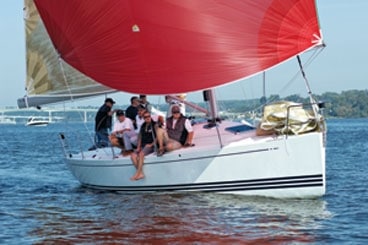
BOTYx35St
Tthe X-35 One Design was an instant success in Europe. After only a single year of production, there were 24 boats at the 2006 Audi X-35 Gold Cup Regatta in Holland. Once we stepped aboard it was easy to see why. Its design and construction result in a boat that’s easily capable of taking on IRC, PHRF, and one-design racing. Its clean and roomy accommodations belowdecks make it a versatile weekender, too. It truly has everything the passionate weekend regatta racer needs.During our test sail, the boat accelerated quickly in the light air and the steering was crisp and frictionless. We slid along upwind at 5.7 knots on the GPS in only 5 knots of wind. With well-placed winches for trimmers, tacking was fluid, and the helmsperson has great visibility from the wheel, allowing concentration on the sails and water ahead, and a good view under the boom to leeward, aft of the jib leech. The 90-percent fractional rig has swept spreaders to accommodate the class-legal 108-percent jibs. There are no running backstays; both topmast bend and forestay tension are adjusted with the topmast backstay control, which exits just forward of the traveler. The jibs trim to tracks mounted outboard of the cabin, and sheets are led through inhaulers to allow tighter sheeting angles in light air. Positive roach from a full-length upper batten in the top of the jib improves the boat’s light-air performance through both the added sail area and interaction with the main aloft. The longer chord length of the upper part of the jib enhances twist in the jib leech as the wind increases, broadening the wind range of each jib. Off the wind we moved along well with a light spinnaker and main. The X-35’s symmetric kite seemed a little retro, but the boat still sailed fast (relatively) and deep. The cockpit layout worked well for jibing and trimming. Other deck design details we like include the grand-prix-rigged mainsheet, the use of Ronstan’s patented “Magic Wheel” system, which gives the main trimmer fingertip control of the backstay, and the jib sheets and afterguys led through fixed fairleads, rather than blocks. Rod rigging is standard on the X-35 with the D2 shrouds discontinuous at the spreader tips. Although this means a trip aloft to adjust the D2s, this arrangement has less stretch differential than continuous rigging. The turnbuckles attach to clean stainless sockets mounted in the rail with no clevis or cotter pins to snag rigging, sails, or hands. The mast is an IRC-friendly tapered aluminum extrusion with tapered aluminum spreaders. X-Yachts molds the hull with fiberglass skins sandwiching a Divinycell foam core to keep the boat light, yet stiff and strong. The outside skin uses vinylester resin for blister resistance; the rest of the boat is polyester. A molded interior grid structure and galvanized-steel keel frame stiffen the hull shell. The keel’s cast-iron fin is bolted through the hull and this frame firmly transfers the sailing loads from both the fin and lead ballast bulb to the hull. Shroud loads are transferred directly to the hull and main bulkhead at the rail, which eliminates the need for chainplate tie rods to a wide spot on the steel frame, and results in a lighter structure. For one-design racing, class rules allow a main, two full-size jibs, a heavy weather jib, two symmetric spinnakers and storm sails. While waiting for one-design growth in the States, X-35 can initially race handicap under IRC (1.055), PHRF (59 to 63), IMS (606 GPH), or ORR (610.5 GPH), and owners will be wise to add asymmetric spinnakers. In light air this boat is fast enough to pull the apparent wind forward to the point that an asymmetric spinnaker will be faster than the light symmetric spinnaker.









